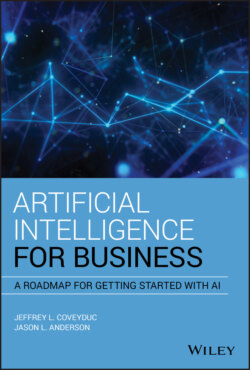Читать книгу Artificial Intelligence for Business - Jason L. Anderson - Страница 8
Case Study #1: FANUC Corporation
ОглавлениеScience fiction has told of factories that run entirely by themselves, constantly monitoring and adjusting their input and output for maximum efficiency. Factories that can do just-in-time (JIT) ordering based on sales demand, sensors that predict maintenance requirements, the ability to minimize downtime and repair costs—these are no longer concepts of speculative fiction. With modern sensors and AI software, it has become possible to build these efficient, self-bolstering factories. Out-of-the-box IoT equipment can do better monitoring today than industrial sensors from 10 years ago. This leap in accuracy and connectivity has increased production threshold limits, enabling industrial automation on a scale never before imagined.
FANUC Corporation of Japan,1 a manufacturer of robots for factories, leads by example. Its own factories have robots building other robots with minimal human intervention. Human workers are able to focus on managerial tasks, whereas robots are built in the dark. This gives a whole new meaning to the industry saying “lights-out operations,” which originally meant servers, not robots with moving parts, running independently in a dark data center. FANUC Japan has invested in Preferred Networks Inc. to gather data from their own robots to make them more reliable and efficient than ever before. Picking parts from a bin with an assortment of different-sized parts mixed together has been a hard problem to solve with traditional coding. With AI, however, FANUC has managed to achieve a consistent 90 percent accuracy in part identification and selection, tested over some 5,000 attempts. The fact that minimal code has gone into allowing these robots to achieve their previously unobtainable objective is yet another testament to the robust capabilities of AI in the industrial setting. FANUC and Preferred Networks have leveraged the continuous stream of data available to them from automated plants, underlining the fact that data collection and analysis is critical to the success of their factory project. FANUC Intelligent Edge Link & Drive (FIELD) is the company's solution for data collection to be later implemented using deep learning models. The AI Bin-Picking product relies on models created via the data collected from the FIELD project. Such data collection procedures form a critical backbone for any industrial process that needs to be automated.
FANUC has also enabled deep learning2 models for situations where there are too many parameters to be fine-tuned manually. Such models include AI servo-tuning processes that enable high-precision, high-speed machining processes that were not possible until recently. In the near future, your Apple iPhone case will probably be made using a machine similar to the one in Figure 1.1.
Most factories today are capable of utilizing these advancements with minor modifications to their processes. The gains that can be achieved from such changes will be able to exponentially elevate the output of any factory.
FIGURE 1.1 Example of a FANUC Robot3
